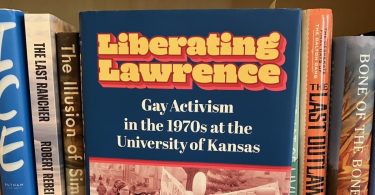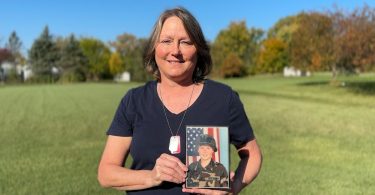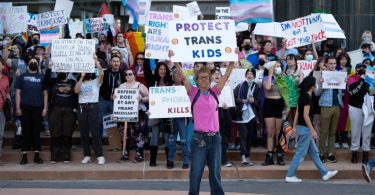British suffragette Emmeline Pankhurst, being jeered by a crowd in New York, around 1911. | Photo by Topical Press Agency/Getty Images
At Digital Pride today, our resident artist has done a live painting of one of the greatest figures of women’s liberation – Emmeline Pankhurst.
Her Suffragettes weren’t actually the biggest group fighting for women’s right to vote in the UK at the start of the last century. But they were true heroes, standing up to government tactics and police brutality. Pankhurst – and her supporters – were instrumental in finally winning us the vote.
What many people do not know is that Pankhurst was also bisexual. But because LGBTI people at that time had to keep their true identities hidden, most people assume she was straight.
If, like me, you feel we should all know more about LGBTI and women’s history, then Pankhurst is surely a significant figure.
The making of a revolutionary
Emmeline Goulden was born in 1858 in Manchester, north west England. Both her parents were politically active. And Emmeline was just 14 when she was first introduced to the suffrage movement – the campaign for women’s right to vote.
Emmeline married Richard Pankhurst, a barrister 24 years older than her, in 1879. He also supported the women’s right to vote. And at the same time as becoming a mother to five, Emmeline remained involved in politics. In particular, she was shocked by how poor people suffered harsh conditions in Manchester’s workhouses.
Richard died young in 1898. We know Emmeline Pankhurst had at least one female relationship, following his death. The diaries of a Suffragette named Mary Blathwayt reveal she had ‘a close relationship’ with the lesbian composer Ethel Smyth. The relationship lasted for some years.
The start of the Suffragettes
Five years later, in 1903, Emmeline founded the Women’s Social and Political Union (WSPU). The WSPU were to become known as the Suffragettes.
Pankhurst and her followers were frustrated by politicians backtracking on their promises to introduce votes for women. They argued that peaceful diplomacy was failing to make progress. So they adopted the mantra ‘deeds, not words’.
Their tactics were physical, but no more violent than those used by male political activists at the time. In particular, they smashed windows. If it’s true they assaulted police officers, it’s also fair to say the police were more often the aggressors. Police officers violently broke up their protests.
When the Suffragettes ended up in jail, they continued their struggle. They went on hunger strikes – and some even refused water. The authorities responded with a brutal regime of force-feeding.
By the time World War I came in 1914, the women’s movement had made the right to vote a central political issue. To support Britain against the ‘German Peril’, Pankhurst ended the militant struggle for the duration of the war. Moreover, the Suffragettes urged women to take over jobs in factories, freeing up men to fight.
A turning point for women
Finally, as the war drew to a close in 1918, parliament granted women the right to a vote.
The Representation of the People Act guaranteed votes to all men over the age of 21 and women over the age of 30. So even then, women weren’t really equal. We weren’t even nearly equal.
You could compare it to the decriminalization of homosexuality in England and Wales in 1967. That only made gay sex legal between two adults aged over 21 in private. Like that, it wasn’t equality, but it was a start.
Now, a century later, we know 1918 was a turning point in the history of women in our country and around the world.
Emmeline Pankhurst the icon
Many women – and their male allies, such as Emmeline’s husband, Richard – helped win the right to vote. Some were Suffragette activists, others toiled in factories during the war, others still used quiet diplomacy.
Every generation of women that has followed them stands on their shoulders. There is much we must still achieve in the UK. Incredibly, 100 years later, men are paid 18.4% more than women in the UK. Clearly, we still need more people to advocate for women’s equality.
Emmeline Pankhurst’s bisexuality is a small part of her story. She was first and foremost a politician, activist and mother of other Suffrage leaders.
But what we know of her sexuality proves a great fact of our LGBTI community. We have been part of every great event in history. We may have had to hide our true natures, but we’ve always been there. And often leading.
Emmeline Pankhurst is a true LGBTI icon. As such, by honoring her today at Digital Pride, in our own small way, I believe we honor all those amazing women who have fought for our equality.
You can watch our painting take shape here:







